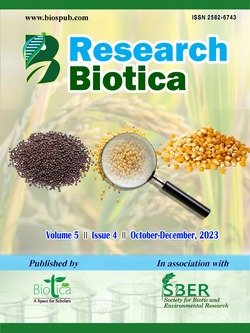
Influence of Different Planting Dates on the Occurrence of Key Pests Affecting Blackgram in the Lower Gangetic Alluvial Plain of West Bengal
A. Banerjee
AICRP on MULLaRP, Directorate of Research, Bidhan Chandra Krishi Viswavidyalaya, Mohanpur, Nadia, West Bengal (741 252), India
Sabyasachi Ray*
Dept. of Agricultural Entomology, Bidhan Chandra Krishi Viswavidyalaya, Mohanpur, Nadia, West Bengal (741 252), India
DOI: https://doi.org/10.54083/ResBio/5.4.2023/139-144
Keywords: Blackgram, Date of sowing, Incidence, Spotted pod borer, Thrips
Abstract
A field oriented experiment was executed over two consecutive summer months in 2019 and 2020 to study the influence of sowing dates of blackgram or urdbean (Vigna mungo L. Hepper) on the population fluctuation of its major pests viz., flower infesting thrips (Megalurothrips sp.) and spotted pod borer or legume pod borer (Maruca vitrata Fabr.). The blackgram variety PU 31 was sown on three different dates, with ten days apart specifically, on the 14th of March, 24th of March and 3rd of April each year, representing early, medium and late sown crops. The experiment recorded fewer incidences of flower thrips in late-sown crop (population of 2.56 per 10 flowers in first year and 1.22 in second year) than early crop (4.71 and 2.42 in those years, respectively), while higher incidences of pod borer was recorded in late-sown crop (larval population of 2.49 plant-1 in first year and 2.58 in second year) than early crop (0.69 and 0.42 in those years, respectively). Given that early and late-sown crops attract more thrips and pod borers, respectively, it may be recommended to sow black gram during the last week of March, especially in the lower Gangetic plains of West Bengal.
Downloads
not found
Reference
Anonymous, 2022a. Blackgram - January to December 2022. Crop Outlook Reports of Andhra Pradesh. Acharya N.G. Ranga Agricultural University, Hyderabad, Telangana. pp. 1-7. URL: https://angrau.ac.in.
Anonymous, 2022b. Black gram Outlook, October 2022. Agricultural Market Intelligence Centre, PJTSAU, Rajendranagar, Hyderabad. pp. 1-4. URL: https://pjtsau.edu.in.
Anvesh, K., Choudhary, S., Kumawat, K.C., Khinchi, S.K., Hussain, A., 2022. Impact of varied sowing dates on incidence of spotted pod borer and gram pod borer on Indian bean, Lablab purpureus var. typicus (L.) sweet in semi-arid region of Rajasthan. Biological Forum - An International Journal 14(1), 1157-1163.
Bakr, M.A., Afzal, M.A., Hamid, A., Haque, M.M., Aktar, M.S., 2004. Blackgram in Bangladesh. Lentil Blackgram and Mungbean Development Pilot Project, Publication No.25, Pulses Research Centre, BARI, Gazipur. p. 60.
Berani, N.K., Damor, M.P., Godhani, P.H., 2018. Impact of date of sowing on lepidopteran insect pest of black gram, Vigna mungo (L.) Hepper. Journal of Entomology and Zoology Studies 6(4), 24-26.
Delic, D., Stajkovic, O., Kuzmanovic, D., Rasulic, N., Knezevic-Vukcevic, J., Milicic, B., 2009. The effects of rhizobial inoculation on growth and yield of Vigna mungo L. in Serbian soils. Biotechnology in Animal Husbandry 25(5-6), 1197-1202.
Duraimurugan, P., Tyagi, K., 2014. Pest spectra, succession and its yield in mung bean and urd bean under changing climatic scenario. Legume Research 37(2), 212-222. DOI: https://doi.org/10.5958/j.0976-0571.37.2.032.
Hadiya, H.R., Patel, D.R., Pathak, D.M., Patel, S.G., 2019. Impact of sowing periods on incidence of sucking pest on summer mungbean. Journal of Entomology and Zoology Studies 8(1), 815-818.
Hamad, S.E., Dubey, S.L., 1983. Losses due to insect pests in North Bihar. Indian Journal of Entomology 1, 136-146.
Justin, G.L.C., Anandhi, P., Jawahar, D., 2015. Management of major insect pests of black gram under dry land conditions. Journal of Entomology and Zoology Studies 3(1), 115-121.
Litsinger, J.A., Barrion, A.T., Bangdog, J.P., dela Cruz, C.G., Canapi, B.L., Apostol, R.F., 1988. Food web, yield loss and chemical control of insect pests of wetland rice -based mungbean in the Philippines. In: Mungbean: Proceedings of the second International Symposium. Asian Vegetable Research and Development Center, Shanhua, Taiwan. pp. 355-365.
Mandal, D., Bhowmik, P., Baral, K., Chatterjee, M.L., 2013. Field efficacy and economics of some insecticides against spotted pod borer (Maruca testulalis Geyer) of black gram. Journal of Crop and Weed 9(2), 177-180.
Naik, M.G., Mallapur, C.P., Naik, A.K., 2019. Field efficacy of newer insecticide molecules against spotted pod borer, Maruca vitrata (Geyer) on black gram. Journal of Entomology and Zoology Studies 7(3), 635-637.
Nitin, R.S.A., 2023. Unveiling the potential of black gram: A nutrient-rich pulse for sustainable agriculture. Biotica Research Today 5(9), 683-685.
Nelson, M.N., Nesi, N., Barrero, J.M., Fletcher, A.L., Greaves, I.K., Hughes, T., Laperche, A., Snowdon, R., Rebetzke, G.J., Kirkegaard, J.A., 2022. Strategies to improve field establishment of canola: A review. Advances in Agronomy 175, 133-177. DOI: https://doi.org/10.1016/bs.agron.2022.05.001.
Prodhan, M.Z.H., Hossain, M.A., Rahman, M.T., Afroze, F., Sarker, M.A., 2008. Incidence of major insect pests of blackgram at different dates of sowing. International Journal of Sustainable Crop Production 3(3), 6-9.
Rusch, A., Valantin-Morison, M., Sarthou, J.P., Roger-Estrade, J., 2010. Biological control of insect pests in agroecosystems: Effects of crop management, farming systems, and seminatural habitats at the landscape scale: A review. Chapter 6. In: Advances in Agronomy. Volume 109. (Ed.) Sparks, D.L. Elsevier. pp. 219-259. DOI: https://doi.org/10.1016/B978-0-12-385040-9.00006-2.
Sehgal, V.K., Ujagir, R., 1988. Insect and pest management of mungbean in India. In: Mungbean: Proceedings of the Second International Symposium. Asian Vegetable Research and Development center, Shanhua, Taiwan. pp. 315-328.
Singh, K.M., Singh, R.N., 1977. Succession of insect pests in greengram and blackgram under dryland conditions at Delhi. Indian Journal of Entomology 39(4), 365-370.
Sreekanth, M., Sreeramulu, M., Rao, R.D., Prasada, V.J., Babu, B., Sarath, B., 2002. Effect of sowing date on Thrips palmi Karny population and peanut bud necrosis virus incidence in greengram (Vigna radiata L. Wilczek). Indian Journal of Plant Protection 30(1), 16-21.
Tiwari, A.K., Shivhare, A.K., 2016. Pulses in India: Retrospect and Prospects. Government of India. Ministry of Agriculture & Farmers Welfare, Publication No.: DPD/Pub.1/Vol. 2/2016. pp. 98-113.
Verdcourt, B., 1970. Studies in the Leguminosae-Papilionoïdeae for the 'Flora of Tropical East Africa': IV. Kew Bulletin 24(3), 507-569. DOI: https://doi.org/10.2307/4102859.
